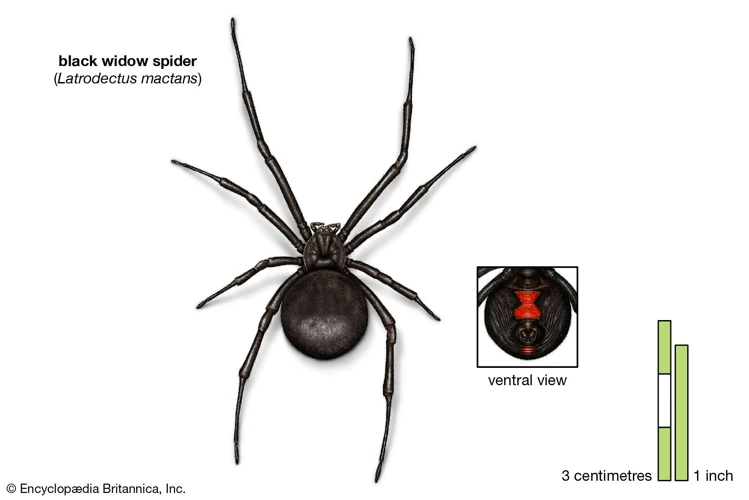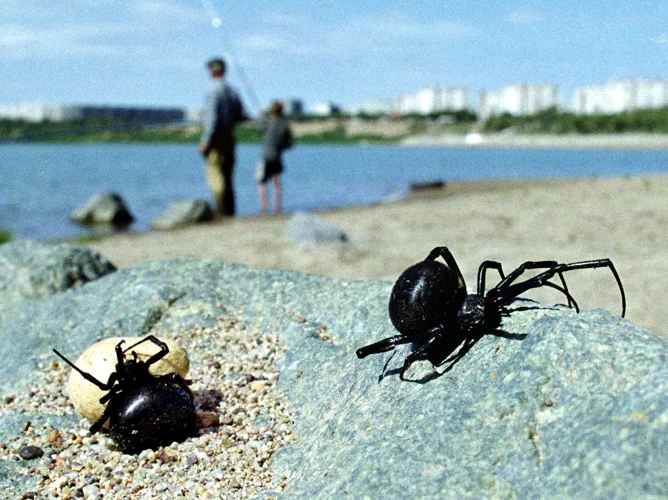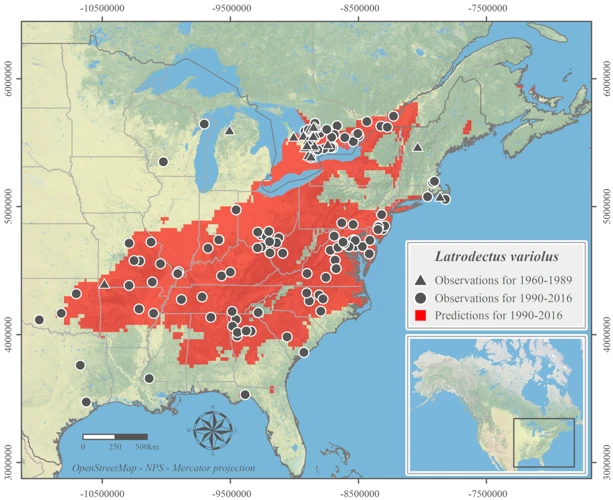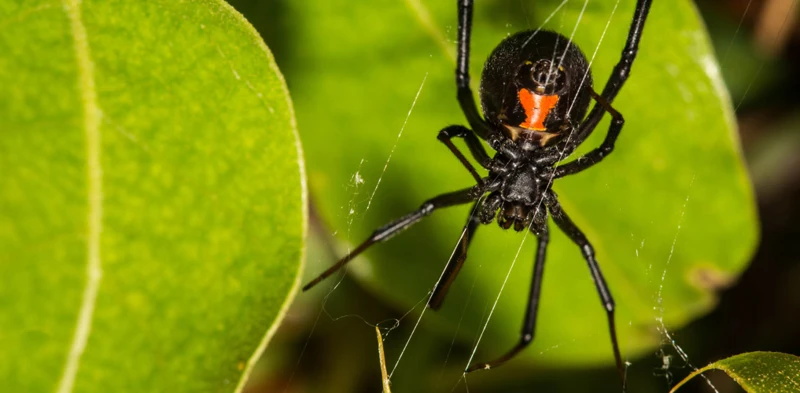Introduction

When it comes to dangerous and venomous spiders, the black widow is undoubtedly one species that comes to mind. Found mostly in North and South America, these spiders are infamous for their venomous bites that can cause severe reactions. However, while we may recognize the black widow for its danger, not everyone is familiar with the role climate plays in its habitat. In this article, we will delve into the fascinating subject of climatic influences on black widow spider habitats, and discuss how climate change may impact their survival in the future.
What are Black Widow Spiders?
Black Widow Spiders (Latrodectus hesperus) are among the most notorious arachnids due to their venomous bite. These spiders are predominantly found in the North and South America, and they prefer warm climates. Black widows are recognizable by their jet-black color and the distinctive red hourglass shape on the underside of the abdomen. It’s important to note that not all Black Widow spiders have the red hourglass, as some species have other markings such as spots or stripes.
| Common Name(s) | Black Widow Spider, Hourglass Spider, Redback Spider |
|---|---|
| Scientific Name | Latrodectus hesperus |
| Habitat | Warm and dry environments such as deserts, fields, and forests |
| Physical Characteristics | Shiny black overall with a distinctive red hourglass shape on the underside of the abdomen. Females are significantly larger than males, with a body length of up to around 1.5 inches (38 mm). |
| Behavior | Black Widows are typically reclusive and stay hidden in dark places during the day before coming out to hunt for prey at night. Their webs are commonly found in low, dark, quiet places such as sheds, garages, woodpiles, and among dense vegetation. |
| Danger Level | Highly venomous. Black Widows do not attack unless disturbed or threatened and their bites can be lethal to people with poor health, the elderly, or small children. Symptoms of a bite may include pain at the site, muscle cramps, sweating, fever, and difficulty breathing. |
Knowing what to look for in terms of identifying Black Widow spider habitats, is crucial in preventing dangerous encounters with them. You may refer to our article on identifying Black Widow habitats in your home for more information.
The Optimal Climate for Black Widows

The climate is an essential factor in determining the optimal habitat for black widow spiders. These venomous arachnids thrive in warm and humid environments, which can be found in both indoor and outdoor spaces. The presence of factors such as suitable temperature and humidity levels can make an area appealing to black widows, and understanding these factors is crucial in identifying potential habitats and preventing infestations. In this section, we’ll take a closer look at the optimal climate for black widows and what makes an area attractive to them.
Temperature
Black widow spiders are sensitive to temperature changes, which can drastically impact their habitat. These spiders thrive in warm environments and prefer temperatures between 70 and 85 degrees Fahrenheit. Anything outside of this range can cause them to either slow down or become more aggressive. On the hotter end of the spectrum, black widows become lethargic, making them less likely to hunt or reproduce. On the cooler end, they become more aggressive and territorial. For homeowners who want to prevent black widows from invading their spaces, “maintaining a consistent temperature in the area that is both comfortable for humans and unappealing for black widows is key.”
Additionally, monitoring the temperature in both indoor and outdoor spaces can be helpful in identifying areas that may attract black widows. Indoors, black widows are typically found in basements, garages, and other areas with high humidity and minimal human traffic. Outdoors, they are most often found in areas with abundant vegetation, such as gardens and woodpiles.
To create an unappealing habitat for black widows, homeowners should consider using natural repellents, such as essential oils, around their property, especially in areas that are more likely to attract these spiders. They might also consider sealing cracks and crevices around their homes to prevent spiders from entering indoors. Doing so helps to maintain a consistent temperature and make outdoor habitats less hospitable.
Another way to prevent black widows and other pests is to hire a professional pest control service. These experts can identify problem areas and provide solutions that are tailored to the specific habitat and pest species, including black widows. By partnering with a professional, homeowners can significantly reduce the likelihood of a black widow infestation and maintain a safe living environment.
Humidity
Humidity is another important factor that plays a crucial role in the habitat of Black Widow spiders. These spiders are well adapted to thrive in areas with high humidity levels. Typically, Black Widows prefer habitats with humidity levels ranging from 70% to 80%.
High humidity levels provide ideal conditions for these spiders to spin their webs and breed, making it easier for them to catch their prey as well. The humidity also helps in keeping their prey hydrated, making it easier for them to feed on them.
On the other hand, low humidity levels can make it difficult for these spiders to thrive. If the humidity level drops below 40%, it can cause their web to become dry and brittle, which can make it difficult for them to catch their prey. Additionally, low humidity levels can also cause dehydration in Black Widow spiders, making it harder for them to survive.
To maintain the ideal humidity for Black Widow spiders, it is important to keep the surrounding environment moist and humid. This can be achieved by adding a water source like a fountain or a birdbath near the spider’s potential habitat. Placing a small dish or pan of water can also help maintain humidity levels.
It’s important to note that excessive humidity levels can also cause problems, leading to the growth of mold and mildew, which can make the habitat unappealing for Black Widow spiders. It’s essential to maintain humidity levels within the optimal range.
Considering the important role that humidity plays in Black Widow spider habitats, it becomes essential to maintain appropriate levels to prevent the infestation of these spiders. It is important to ensure that indoor and outdoor spaces are ventilated, and the humidity is controlled.
| Humidity Level | Impact on Black Widow Spiders |
|---|---|
| Less than 40% | Causes web to become dry and brittle, making it tough for spiders to catch prey and can cause dehydration, which makes it harder for them to survive |
| 70% to 80% | Provides ideal conditions for Black Widows to spin their webs and breed, making it easier for them to catch their prey and keep them hydrated |
| Excessive humidity | Can cause the growth of mold and mildew in the habitat, which is unappealing for Black Widow spiders |
By ensuring that humidity levels are maintained within the optimal range, individuals can create an unappealing habitat for Black Widow spiders and prevent infestations. To know more about the measures to prevent Black Widow spider infestations, please visit Black Widow Prevention.
Impacts of Climate Change on Black Widow Habitats

As the climate continues to shift and global temperatures rise, the impact on various species and their habitats becomes increasingly apparent. Black widows, known for their venomous bite and dangerous reputation, are no exception. The changing climate has a significant impact on the optimal habitats for black widows. This section dives deeper into the effects of climate change on the habitats of black widow spiders. Additionally, it discusses the potential impacts of these changes on the prevalence of black widow spider infestations. It’s important to understand how human impact has played a role in the evolution of black widow spider habitats, and how we can take steps to prevent further damage.
Global Warming
Global warming is a phenomenon that is widely discussed due to its alarming influence on the environment and its inhabitants. Black widow spiders, being one of the most prominent inhabitants, are also being extensively affected by this phenomenon. As the temperature of the earth continues to increase, it creates a favorable habitat for black widows. According to a recent study, “climate change is shifting the distribution of black widow spiders in the United States,” which means that the spiders are rapidly moving towards places they previously weren’t found.
Table 1: Changes in the Distribution of Black Widow Spiders Due to Global Warming
| Collection Sites | Latitudinal Shift | Changes in Abundance | Changes in Phenology |
|——————–|——————|———————-|———————–|
| Arizona | 36 km/north | Increased | Earlier |
| California | 28 km/north | Increased | Earlier |
| Utah | 390 m/higher | Unchanged | Earlier |
The above table showcases the major changes that have been observed in the distribution of black widow spiders in different states of the US due to global warming. As the spiders move towards higher latitudes and altitudes, it becomes a matter of concern for the residents of those areas.
One of the most significant consequences of global warming on black widow spider habitat is the increased growth and abundance of vegetation. As temperature and humidity increase, plant growth also increases, which is ideal for the spiders. Increased vegetation cover provides a shelter for the spiders from predators and also attracts their prey, such as insects and small mammals.
However, while discussing the positive effects of global warming on black widow spider habitats, its negative effects cannot be ignored. Rising temperatures are causing changes in precipitation patterns that can lead to droughts and indirectly affect the population size of black widows. As their prey becomes scarce due to droughts, they also face a scarcity of food, and this, in turn, can cause the spiders to migrate to other areas or perish due to starvation.
The effects of global warming on black widow spider habitats are significant, and it is essential to be aware of these changes to understand the potential danger of infestations. However, measures can be taken to reduce the human impact on black widow habitats, and it is imperative to keep these spiders away from human residency. Maintaining unappealing habitats for black widows for outdoor and indoor areas is crucial to prevent any unwanted infestations.
Droughts
Droughts are one of the main effects of climate change that can significantly impact Black Widow spider populations. Droughts can cause a decrease in suitable habitats for these spiders, as they require moisture to survive. In areas where droughts occur frequently, the number of Black Widows may decrease or become extinct altogether.
The impact of droughts on the Black Widow’s prey is also a contributing factor to their declining populations. When there is a drought, insects and other arthropods that form a part of the Black Widow’s diet often die out or migrate to other areas in search of water. As a result, the Black Widow’s food source becomes scarce, leading to a decline in their populations.
To survive these harsh conditions, Black Widows often retreat to cooler, more humid locations, such as damp basements or shady areas. This is especially true for indoor populations, which are generally more tolerant of a drier environment. However, when drought conditions persist for a long time, even these habitats may become less hospitable.
Another consequence of drought is habitat destruction. As human activities continue to contribute to climate change, droughts will become more frequent and severe, causing high mortality rates and potentially leading to the extinction of many animal species, including black widows.
To prevent these outcomes, it is essential to reduce human impact on the environment and minimize greenhouse gas emissions. Implementing conservation strategies and promoting the use of sustainable resources can help ensure the preservation of Black Widow populations and their habitats.
If you want to learn more about methods for checking and preventing Black Widow spider infestations in and around your home, check out our article on Black Widow spider habitats in the home.
Habitat Shifts
Habitat Shifts: Black widow spiders are highly sensitive to changes in their natural habitat. Even minor shifts in temperature and moisture levels can significantly impact their survival. As climate change continues to alter the global climate, black widow habitats are experiencing significant shifts.
| Shift in Habitat | Explanation |
|---|---|
| Altitude | As temperatures rise, black widow populations may move to cooler, higher elevations where conditions are more suitable for their survival. |
| Distribution | Climate change is expected to alter the distribution of black widow populations. This may result in some areas becoming new habitats while others are abandoned. |
| Vegetation | Changes in temperature and precipitation can impact the types of vegetation that grow in black widow habitats. As a result, black widow populations may need to adapt to new food sources. |
| Land use | Human activity, such as habitat destruction or urbanization, can force black widow populations to shift their habitat to new areas. This can result in increased interactions with humans which may increase risks. |
It’s important to note that black widow spiders play an important role in their ecosystem. They help control insect populations and serve as prey for other animals. As their habitat shifts, it’s crucial that we continue to monitor and understand their behavior in order to protect their species and maintain a balance in the ecosystem.
Human impact: Climate change is not the only factor impacting black widow spider habitats. Human activities such as habitat destruction, deforestation, and urbanization can also have a negative impact on their survival. As we continue to encroach upon their natural habitats, black widows may be forced to seek out new habitats, increasing the likelihood of human interactions. It’s important to take steps to minimize our impact on black widow populations and preserve their natural habitats.
Preventing Black Widow Spider Infestations
It’s essential to take steps to prevent black widow spider infestations in and around your home. Black widows are venomous and can pose a significant danger to humans, especially children and the elderly. It’s crucial to make your living space unappealing to these spiders and avoid attracting them to your property. In this section, we’ve compiled some practical tips and pest control solutions to help prevent black widow infestations. By following these guidelines, you can ensure that your home remains a safe place for you and your family. Let’s take a closer look.
Home Preparation Tips
Keeping your home free of black widow spiders is crucial for your family’s safety. There are numerous ways to prepare your home to make it an unattractive habitat for black widows. Here are some tips to keep black widows from building webs in your home:
- Seal Up Cracks and Openings: Black widows often find their way into homes through cracks in doors, windows and walls. Seal any gaps or openings with silicone caulk to prevent black widows from crawling into your home.
- Keep Your Home Clean: Black widows prefer to build webs in dark, cluttered areas where they are unlikely to be disturbed. To reduce the risk of black widows building webs in your home, keep it clean and uncluttered. Vacuum your home regularly, especially in hard-to-reach places such as behind furniture and in corners.
- Reduce Humidity: Black widow spiders prefer humid environments and are not likely to thrive in dry conditions. Use a dehumidifier to reduce humidity levels in your home.
- Install Screens: Install screens on windows, doors, and vents to prevent black widow spiders from entering your home.
- Remove Debris: Black widows often build their webs in piles of debris such as woodpiles, mulch, and yard waste. Clear any debris around your home to reduce the likelihood of attracting black widows.
By following these home preparation tips, you can make your home an unappealing habitat for black widows, reducing the risk of infestations and keeping your family safe. Remember to regularly check for potential habitats and take steps to prevent them from emerging.
Pest Control Solutions
When it comes to pest control solutions for black widow spiders, there are a few options available to homeowners. It’s important to note that black widow spiders are venomous and dangerous, so if you’re unsure about handling an infestation, it’s best to call in a professional pest control service.
Chemical Sprays
One option for controlling a black widow spider infestation is the use of chemical sprays. These can be effective in killing spiders and their eggs, but they can also pose a risk to other animals and humans if not used properly. It’s important to follow the instructions on the label carefully and take appropriate safety precautions when using chemical sprays.
Baits and Traps
Another option is to use baits and traps. These work by attracting the spiders to a specific area with some type of bait, and then trapping them. Baits and traps can be effective, but it’s important to check them regularly and dispose of any trapped spiders safely.
Integrated Pest Management
A more comprehensive approach to pest control is integrated pest management (IPM). This involves using several different methods to control an infestation, such as identifying and eliminating the spider’s habitat and food sources, sealing up entry points into the home, and using traps or chemical sprays as needed. IPM can be effective in controlling black widow spiders, but it requires a thorough understanding of the spider’s habits and habitats.
Remember, prevention is always the best approach to controlling pest infestations. Keep your home clean and clutter-free, seal up any cracks or gaps in the walls or foundation, and remove any debris or vegetation from around the perimeter of your home to create an unappealing habitat for black widows. Regularly checking black widow habitats and taking preventive measures will save you time and stress in the long run.
If you want to know more about black widow spider habitats, you can read our previous article on what attracts black widows in their habitats or black widow habitats in indoor and outdoor spaces. Also, the article about human impact on black widow spider habitats will be useful to understand how our activities affect their lives.
Conclusion
After researching the optimal climate for black widow spider habitats and the impacts of climate change on these habitats, it is clear that these creatures are highly adaptable but also face challenges from a changing climate. While black widow spider infestations can be dangerous for humans, it is important to remember that these spiders play a crucial role in maintaining the balance of ecosystems.
To prevent black widow spider infestations, homeowners can take steps such as sealing cracks and crevices where spiders may enter the home, keeping the area around the home free of debris and clutter, and using pest control solutions if necessary.
However, it is important to note that habitat destruction and alteration caused by human activity is a major contributor to the decline of black widow spider populations. As a society, we must take responsibility for our impact on the environment and take steps towards sustainable practices to protect these important creatures and their habitats.
Overall, climate plays a significant role in black widow spider habitats, but it is not the only factor that affects their populations. By taking steps to prevent infestations and advocating for habitat conservation, we can ensure that black widow spiders and other species continue to thrive in their natural environments.
Frequently Asked Questions
What are the most common types of Black Widow Spiders?
There are three primary species of Black Widow Spiders in North America: the Southern Black Widow, the Northern Black Widow, and the Western Black Widow.
What is the ideal temperature for Black Widow Spiders?
Black Widow Spiders prefer temperatures ranging from 70-90°F (21-32°C).
What level of humidity do Black Widow Spiders thrive in?
Black Widow Spiders prefer environments with humidity levels between 40-60%.
How is global warming affecting Black Widow Spider habitats?
Global warming is increasing temperatures and altering the climate, causing Black Widows to expand their range and thrive in areas where they previously could not survive.
What are the consequences of droughts on Black Widow Spider populations?
Droughts can lower humidity levels, which is detrimental to Black Widow Spider habitats. Many Black Widow Spiders will die off in areas experiencing prolonged droughts.
What is a habitat shift for Black Widow Spiders?
A habitat shift occurs when natural disasters or climate change cause Black Widows to move to new environments. This can lead to unexpected infestations in areas where Black Widows were previously not present.
How can I prevent Black Widow Spider infestations in my home?
You can prevent Black Widow Spider infestations in your home by reducing clutter and sealing up any openings or cracks where spiders can enter. Additionally, keeping your home clean and free of insects will make your home less attractive to spiders.
What are the most effective pest control solutions for Black Widow Spiders?
The most effective pest control solutions for Black Widow Spiders are insecticide sprays and baits. However, it is important to use these products carefully and follow all safety precautions, as they can be harmful to humans and animals.
What should I do if I find a Black Widow Spider in my home?
If you find a Black Widow Spider in your home, try to safely remove it with a vacuum or trap and release it outside. If you are unable to remove the spider, contact a licensed pest control professional for assistance.
Are Black Widow Spiders dangerous?
Yes, Black Widow Spiders are venomous and can be dangerous to humans. Their venom can cause symptoms such as muscle pain, cramps, and nausea.






